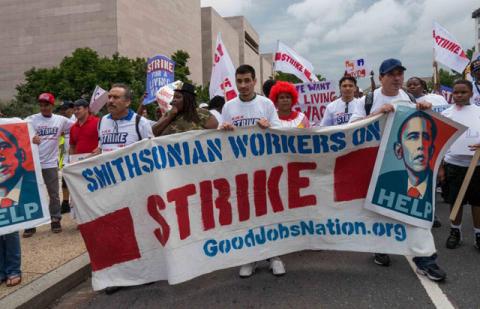By Kate Irby
McClatchy Washington Bureau
WASHINGTON
Jonathan Ross, a restaurant worker at one of the famous Smithsonian Institution museums, went on a one-day strike Thursday because he’s tired of trying to support himself and his 15-year-old daughter on $10,000 per year without benefits.
“I’m here because I can’t afford to take care of me or my family,” he said. “Me and my daughter share a room in a boarding house, and with the money that I make right now I can barely afford to even feed us.”
Ross was one of about 100 protesters gathered Thursday morning in front of the Smithsonian Air and Space Museum, calling on President Barack Obama to issue an executive order to force federally contracted businesses, such as restaurants within the Smithsonian, to provide all workers with a “living wage.” In the District of Columbia, that would mean employers currently paying workers at the minimum wage of $8.25 per hour would have to pay at least $13.68 per hour to workers with no children, or at least $26.37 per hour if the employee had one child.
Speakers said the strikers represent a population of 2 million workers nationwide who are employed by private businesses contracted with the government who struggle to make ends meet.
Obama voiced support for raising the minimum wage in his State of the Union address in February, but he has remained quiet on the concept of a living wage. The White House did not respond to a request for comment.
Smithsonian spokeswoman Linda St. Thomas clarified that the protesters were not directly employed by Smithsonian museums but by private businesses such as McDonald’s within the museums, so there was nothing the Smithsonian could do to correct the issue.
“We understand their concerns, living in the Washington area on $25,000 per year, we hear them,” she said. “But we don’t have direct impact on what McDonald’s does with their employees.”
St. Thomas said the restaurants were fully staffed Thursday and no restaurants closed because of the one-day strike.
The strikers chanted in both English and Spanish in front of the Smithsonian. “Can’t survive on $8.25,” they repeated, adding that if they didn’t get the living wage they were going to “shut it down.” Most held signs calling for a living wage, and one showed Obama’s iconic hope poster, but in place of “Hope,” it read, “Help.”
Some strikers, saying they could not afford babysitters, held toddlers in their arms or pushed them in strollers as they chanted along with the group and listened to speakers.
Doug Hall, director of the Economic Analysis and Research Network at the Economic Policy Institute, a liberal Washington think tank, spoke to the crowd about the economics of a living wage. He said even the poverty line no longer accurately measures how much people need to survive, as the cost of living has gone up but wages remain stagnant.
“The problem is especially glaring in Washington, D.C., where a family needs to bring home more than $88,000 to live securely,” Hall said. A full-time employee making minimum wage in D.C. would make just over $17,000 annually.
Ana Hernandez, who has worked at a restaurant in the Air and Space Museum for nine years, spoke about her struggles to raise five children on only $8 an hour, which is below minimum wage in D.C.
“It’s really hard for me to be able to take my kids to the park, to be able to feed them, to be able to give them clothing,” she said through a translator. “I can’t afford it.”
After speakers finished, actors climbed into a bed together in the middle of the street after one dressed as Uncle Sam gave one playing Ronald McDonald a check for $1 million, suggesting that the government pays CEOs millions while low-wage workers struggle to get by.
Travis Dupree, a spokesman for Good Jobs Nation, a group that helped organize the strike, said it’s about restoring the middle class.
“D.C. is now the Tale of Two Cities – it’s the rich and the not so rich,” he said. “The middle class has disappeared.”
In another flashpoint, the D.C. City Council voted Wednesday to require large retailers such as Walmart to pay its employees a 50 percent premium over the city’s minimum wage, which would still fall far short of what groups such as the Economic Policy Institute consider a living wage. Walmart has threatened to abandon its plans to open six stores in D.C. because of the council action.
That vote does not affect the Smithsonian museums.
Email:kirby@mcclatchydc.com; twitter @kateirby


Spread the word